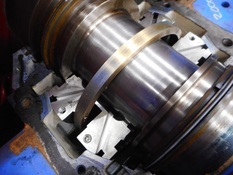Types of Sleeve Bearings & Sleeve Bearing Repair - HECO
April 18, 2020
Bearings account for about 51% of all electric motor failures and the most common sources of failure involve normal wear and tear, lubrication issues, contamination, or electrical damage that affects the bearing surfaces. While rolling element bearings are the most common type of bearing, sleeve bearings are found most often in larger motors that require a bearing life that rolling element bearings simply cannot achieve.
Purpose of Sleeve Bearings
Sleeve bearings go by several different names, including Babbitt bearings, bushings, journal bearings and plain bearings, and are crucial to the correct operation of rotating equipment that they are part of. They can serve multiple purposes at the same time: constrain motion, serve as a guide, provide support, and reduce friction. They work with linear, rotating, and oscillating motion. Sleeve bearings are cylindrical in shape and are straight, as opposed to tapered or conical.
Bearing-to-Shaft Clearance
Bearing-to-shaft clearance has a huge impact on sleeve bearing life and performance and there are tons of guidelines and rules of thumb that you can find to tell you how much clearance you need. However, according to EASA, there are certain things that are always going to affect proper clearance:
- Whether the shaft is vertical or horizontal
- Oil viscosity and load
- How much weight the bearing will be supporting
- Ratio of the length to the diameter
- Peripheral speed of the shaft journal
The higher the torque, the wider the shaft diameter needs to be. A heavier rotor will require a larger bearing. However, for faster speeds, the journal diameter is going to have to be smaller. Then, the longer the bearing the greater the clearance.
Bearing-to-Housing Clearance
Bearing-to-shaft is not the only kind of clearance that may require attention, however. Too many times the bearing-to-housing clearance is overlooked. This type of clearance is necessary because the coefficients of thermal expansion between the different materials that make up a functional sleeve bearing (i.e., outer surface, Babbitt, shaft, housing). This can lead to a host of problems.
Sleeve Bearing Repair
There are many sleeve bearing issues that can be repaired. For example, we referenced bearing clearances just a moment ago. In some instances, an adjustment to the clearance between the shaft and bearing can resolve issues with vibration or insufficient lubrication. In some instances, the Babbitt material may need to be replaced or the surface modified, and design changes may need to be made to the bearing housing. The method used to replace this Babbitt material is called Spin Casting or Centrifugal Casting.
Lubrication is a key factor in how long a bearing will last, so many bearing issues can be resolved by addressing a lack of lubrication. This may be as simple as changing the type of lubrication used (i.e., viscosity, additives) or making modifications to oil rings and oil distribution grooves. Guides and wipers can also be integrated into the bearing to help keep the oil better distributed. If oil recovery is a problem, then an end seal and a drain groove can be added.
Lubrication leaks are most often the result of failed oil seals, so in some instances a different type of geometry of seal may be recommended. Labyrinth seals seem to work especially well with sleeve bearings, but there are many parameters involved in choosing the right one for your application.
In addition, there can be electrical issues that can result in damage to sleeve bearings and ball bearings. This type of damage is the result of electric motor shaft circulating currents.
Conclusion
Bearing issues can be quite challenging, especially when it involves clearances and proper lubrication. The good news is that there are many issues that can be repaired and experts that can help guide you in that process. If you are having bearing issues, remember that HECO is an EASA-accredited repair shop with the skills and knowledge to help you get the most out of your sleeve bearings.
Posted in Product Sales, Repair
